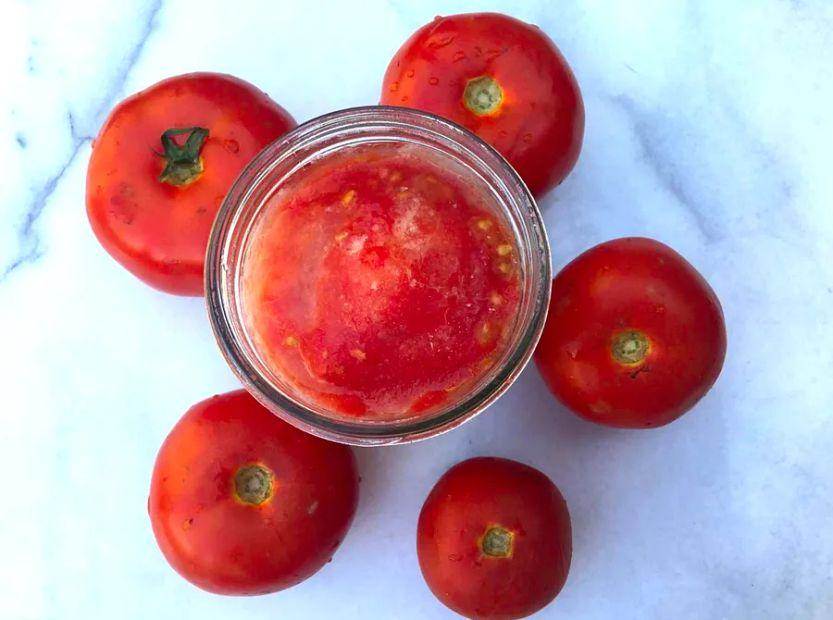How to Freeze Fresh Tomatoes

Tips for Freezing Tomatoes
Freezing tomatoes is a simple way to preserve the flavor of fresh, ripe tomatoes without the hassle of canning. It's a great option if you have too many tomatoes to eat before they spoil but don't want to go through the effort of canning them, or if you don’t have enough for a full canning batch.
Keep in mind that frozen tomatoes will become soft once thawed, so they aren’t suitable for eating raw, like in a BLT sandwich. However, they’re perfect for cooking. Freezing tomatoes for sauce is especially useful during peak tomato season when you don’t have time to make sauce right away.

Recommended Containers for Freezing
Tomatoes can be frozen in various forms: whole, stewed, or as sauce. The best containers for freezing are plastic food storage containers with secure lids or straight-sided mason jars. It's important to avoid jars with shoulders (those with curved tops) because the expanding water content in the tomatoes during freezing can cause the jar to crack. Make sure to leave about an inch of headspace when filling the jars to prevent this issue.
Freezing in Recipe-Sized Portions
For convenience, freeze tomatoes in portions that match your typical recipe needs. Pint-sized jars (2 cups, or roughly the size of a 14.5-ounce can of tomatoes) or quart-sized jars (4 cups, equal to a 28-ounce can) are the most common and practical sizes to use.
For jar lids, plastic mason jar lids, also known as storage lids, are the most reliable choice.

Best Types of Tomatoes for Freezing
You can freeze any variety of tomato — from slicing and beefsteak tomatoes to paste and cherry tomatoes. However, it’s essential to use tomatoes that are in top condition. While they don't have to be perfect in appearance, they should be fully ripe. Freezing under-ripe or subpar tomatoes will lead to unsatisfactory results.
Frozen tomatoes will stay good in the freezer for up to six months.
Avoid Freezing Tomatoes on a Baking Sheet
Don’t freeze tomatoes by placing them, whole or cut, on a baking sheet to freeze before transferring them to freezer bags. This method exposes the tomatoes to too much air, leading to freezer burn and a poor taste.
How to Freeze Whole Tomatoes

1. Wash and Prep the Tomatoes
Clean the tomatoes thoroughly and remove the stems. Then, use a paring knife to score an 'X' at the bottom of each tomato. Cherry tomatoes don’t need to be scored, so skip this step for them.
2. Blanch the Tomatoes
Boil a large pot of water, and then blanch the tomatoes in batches. Place them in the boiling water for about 30 seconds, or until the skin around the scored area begins to peel. The time may vary depending on the size of the tomatoes.

3. Immerse the Tomatoes in Ice Water
Using a slotted spoon, transfer the tomatoes to an ice water bath to stop the cooking process. Then, place them in a colander over a bowl to catch any excess liquid that may drain off.
4. Peel the Tomato Skins
Once the tomatoes have cooled enough to handle, peel off the skins. For cherry tomatoes, simply give them a gentle squeeze, and the skins will slip right off. Be sure to catch any juice that comes out during this process.

5. Pack the Tomatoes into Jars
Carefully pack the tomatoes—whether whole, halved, or quartered—into freezer containers or straight-sided jars. Be sure to leave about one inch of headspace at the top to allow for expansion during freezing.

When using jars, there may be air pockets between the tomatoes, which can lead to freezer burn. To eliminate these gaps, gently insert a dinner knife to release the trapped air.

Ensure the tops of the tomatoes are completely submerged in liquid, pressing them down if needed. If you’re using ripe tomatoes, they should release enough juice to cover them adequately.

6. Seal the Jars
Seal the jars with plastic lids and place them in the freezer.
How to Freeze Stewed Tomatoes

By briefly cooking the tomatoes, you create a more concentrated product than freezing them raw. This method also reduces the risk of freezer burn, as the diced tomatoes are submerged in their own cooked juice, protecting them from exposure to air.
1. Wash and Prepare the Tomatoes
Start by washing the tomatoes and removing their stems. Use a paring knife to score the bottom of each tomato with an X, unless you're freezing cherry tomatoes, which don't require scoring.
2. Blanch the Tomatoes
Boil a large pot of water, then blanch the tomatoes a few at a time by placing them in the water for about 30 seconds, or until the skin begins to peel away at the scored area. The exact time may vary based on the tomato size.
3. Chop the Tomatoes
Chop the tomatoes and transfer them to a pot. Bring the mixture to a boil, then reduce the heat to simmer, cooking uncovered until the tomatoes soften—around 10 minutes, or longer for larger batches.
4. Pack Tomatoes into Freezer Containers
Allow the tomatoes to cool before transferring them into freezer containers or jars. Be sure to leave about one inch of space at the top. Seal with plastic lids and place in the freezer.

How to Freeze Tomato Sauce
If freezer space is limited, converting fresh tomatoes into sauce before freezing them is the most efficient way to save room.
You'll also need:
A food mill with a fine-texture disk

1. Process the tomatoes through a food mill
Follow the steps for freezing stewed tomatoes as outlined earlier, then strain them through a food mill once they've cooled.
2. Pack the sauce into freezer containers
Pour the sauce into freezer-safe containers or jars, making sure to leave an inch of space at the top.
3. Seal the containers
Secure the jars with their lids and place them in the freezer.

1

2

3

4

5
Evaluation :
5/5